INS/GPS Integrated Navigation for Unmanned Ships Based on EEMD Noise Reduction and SSA-ELM
Abstract
1. Introduction
2. INS/GPS Integrated Navigation System
2.1. INS System Error Equation
- Attitude error equation:where the superscript n indicates the navigation coordinate system (n system), is the attitude error matrix, is the angular rate vector of the earth relative to the system, is the angular velocity vector from the system to the earth and can be expressed as (2), is the transformation matrix from the to n system, and is the random drift of the gyroscope under the b system.
- Velocity error equation:where, in n system, is the specific force vector measured by the accelerometer, is the gravity error, is the conversion matrix from the to system, and in the n-coordinate system, is the deviation of the accelerometer.
- INS position error equation:where the longitude, latitude, and earth height of the carrier position are , , and respectively; , , and represent their corresponding errors; , , and . are the velocities of the carrier in the three directions of ENU in the n system; , , and are their corresponding errors; and and are the radii of curvature on the meridian and the primordial perpendicular, respectively.
2.2. Extended Kalman Filter
- 1.
- Time update:
- 2.
- Measurement update:
2.3. Proposed INS/GPS Integrated Navigation System Framework
3. Proposed Method
3.1. EEMD Denoising
- 1.
- The overall average number M and the amplitude coefficient k of white noise are set. In this paper, M is 100, and k is 0.2 times the signal standard deviation.
- 2.
- A random Gaussian white noise sequence is added to the original signal to obtain a new signal .
- 3.
- EMD decomposition is performed on the new signal to obtain IMF components and a residual component ,
- 4.
- Steps 2 and 3 are repeated for M times of EMD decomposition, and the means of all IMF and participating components are calculated to obtain the EEMD decomposition result.
3.2. SSA-ELM Model
3.2.1. Sparrow Search Algorithm
- 1.
- Initialize the population. The total population of sparrows is expressed as Set the number of sparrows aware of danger, the number of discoverers, the maximum number of iterations and the alarm threshold .
- 2.
- Select the mean square error (MSE) as the fitness function to calculate the fitness value of each sparrow, then identify the best and worst fitness values, which are respectively and .
- 3.
- Use (19) and (20) to calculate the new position of the discoverer, the forager, and the sparrow aware of the danger. If the fitness value of the new position is better than that of the previous position, the position will be updated.
- 4.
- Iterate, repeat step 3, and constantly update the position of the best sparrow. When the number of iterations increases , the iteration should be stopped. The optimal solution is the sparrow of the lowest fitness value in all iterations.
3.2.2. Extreme Learning Machine
3.2.3. SSA-ELM Model
- 1.
- The three-axis acceleration and angular velocity are obtained after noise removal and confirmed as input after data processing. Subsequently, they are output as the INS position and velocity errors.
- 2.
- The SSA and ELM parameters, sample weights, and output weights are initialized. The MSE of ELM is obtained through calculation, the fitness function is selected, and the fitness value is calculated, as shown in (28). The MSE after ELM training is taken as the SSA fitness value.
- 3.
- The fitness value corresponding to each sparrow and the sparrow position corresponding to the best fitness are calculated using the SSA (see (17–21)), and iteration is done to update the best fitness value and position.
- 4.
- We determine whether the updated optimal position and adaptation value meet the maximum number of iterations. Subsequently, the optimal initial weight and threshold of ELM are obtained, and the ELM algorithm is used for prediction.
4. Results and Discussion
4.1. Experiment
4.2. EEMD Denoising
4.3. SSA-ELM
5. Conclusions
Author Contributions
Funding
Acknowledgments
Conflicts of Interest
References
- Zhang, C.; Cao, C.; Guo, C.; Li, T.; Guo, M. Navigation multisensor fault diagnosis approach for an unmanned surface vessel adopted particle-filter method. IEEE Sens. J. 2021, 21, 27093–27105. [Google Scholar] [CrossRef]
- Noureldin, A.; Karamat, T.B.; Eberts, M.D.; EI-Shafie, A. Performance Enhancement of MEMS-Based INS/GPS Integration for Low-Cost Navigation Applications. IEEE Trans. Veh. Technol. 2009, 58, 1077–1096. [Google Scholar] [CrossRef]
- Bao, J.; Li, D.; Qiao, X.; Rauschenbach, T. Integrated navigation for autonomous underwater vehicles in aquaculture: A review. Inf. Process. Agric. 2020, 7, 139–151. [Google Scholar] [CrossRef]
- Ansari-Rad, S.; Hashemi, M.; Salarieh, H. Pseudo DVL reconstruction by an evolutionary TS-fuzzy algorithm for ocean vehicles. Measurement 2019, 147, 106831. [Google Scholar] [CrossRef]
- Atia, M.M.; Liu, S.; Nematallah, H.; Karamat, T.B.; Noureldin, A. Integrated indoor navigation system for ground vehicles with automatic 3-D alignment and position initialization. IEEE Trans. Veh. Technol. 2015, 64, 1279–1292. [Google Scholar] [CrossRef]
- Mu, X.; He, B.; Wu, S.; Zhang, X.; Song, Y.; Yan, T. A practical INS/GPS/DVL/PS integrated navigation algorithm and its application on Autonomous Underwater Vehicle. Appl. Ocean Res. 2020, 106, 102441. [Google Scholar] [CrossRef]
- Xu, Q.; Li, X.; Chan, C.Y. Enhancing localization accuracy of MEMS-INS/GPS/in-vehicle sensors integration during GPS outages. IEEE Trans. Instrum. Meas. 2018, 67, 1966–1978. [Google Scholar] [CrossRef]
- Liu, Y.; Fan, X.; Lv, C.; Wu, J.; Li, L.; Ding, D. An innovative information fusion method with adaptive Kalman filter for integrated INS/GPS navigation of autonomous vehicles. Mech. Syst. Signal Process. 2018, 100, 605–616. [Google Scholar] [CrossRef]
- Wang, Q.; Liu, S.; Zhang, B.; Zhang, C. FBLS-Based Fusion Method for Unmanned Surface Vessel Positioning Considering Denoising Algorithm. J. Mar. Sci. Eng. 2022, 10, 905. [Google Scholar] [CrossRef]
- Silson, P.M.G. Coarse Alignment of a Ship’s Strapdown Inertial Attitude Reference System Using Velocity Loci. IEEE Trans. Instrum. Meas. 2011, 60, 1930–1941. [Google Scholar] [CrossRef]
- Li, J.; Song, N.; Yang, G.; Li, M.; Cai, Q. Improving positioning accuracy of vehicular navigation system during GPS outages utilizing ensemble learning algorithm. Inf. Fus. 2017, 35, 1–10. [Google Scholar] [CrossRef]
- Godha, S.; Cannon, M.E. GPS/MEMS INS integrated system for navigation in urban areas. GPS Solut. 2007, 11, 193–203. [Google Scholar] [CrossRef]
- Tang, J.; Fu, Z.; Deng, Z. Identification method for RLG random errors based on Allan variance and equivalent theorem. Chin. J. Aeronaut. 2009, 22, 273–278. [Google Scholar] [CrossRef]
- Song, J.; Shi, Z.; Du, B.; Han, L.; Wang, H.; Wang, Z. MEMS gyroscope wavelet de-noising method based on redundancy and sparse representation. Microelectron. Eng. 2019, 217, 111112. [Google Scholar] [CrossRef]
- Eftekhari, H.R.; Ghatee, M. Hybrid of discrete wavelet transform and adaptive neuro fuzzy inference system for overall driving behavior recognition. Transport. Res.–Traf. Psychol. Behav. 2018, 58, 1369–8478. [Google Scholar] [CrossRef]
- Yang, X.H.; Ren, J.X.; Zhao, X.M.; Chen, R. MEMS gyro signal de-noising based on adaptive stationary wavelet threshold. Adv. Mater. Res. 2012, 466, 986–990. [Google Scholar] [CrossRef]
- Sheng, G.; Gao, G.; Zhang, B. Application of improved wavelet thresholding method and an RBF network in the error compensating of an MEMS gyroscope. Micromachines 2019, 10, 608. [Google Scholar] [CrossRef]
- Abdolkarimi, E.S.; Mosavi, M.R. A low-cost integrated MEMS-based INS/GPS vehicle navigation system with challenging conditions based on an optimized IT2FNN in occluded environments. GPS Solut. 2020, 24, 108. [Google Scholar] [CrossRef]
- Liu, H.; Jia, J.; Lin, Z.; Wang, Z.; Gong, H. Relationship between net primary production and climate change in different vegetation zones based on EEMD detrending—A case study of Northwest China. Ecol. Indic. 2021, 122, 107276–107287. [Google Scholar] [CrossRef]
- Wu, Z.; Wang, W. INS/magnetometer integrated positioning based on neural network for bridging long-time GPS outages. GPS Solut. 2019, 23, 88. [Google Scholar] [CrossRef]
- Chen, X.; Shen, C.; Zhang, W.; Tomizuka, M.; Xu, Y.; Chiu, K. Novel hybrid of strong tracking Kalman filter and wavelet neural network for GPS/INS during GPS outages. Measurement 2013, 46, 3847–3854. [Google Scholar] [CrossRef]
- Liu, F.; Sun, X.; Xiong, Y.; Huang, H.; Guo, X.; Zhang, Y.; Shen, C. Combination of iterated cubature Kalman filter and neural networks for GPS/INS during GPS outages. Rev. Sci. Instrum. 2019, 90, 125005–1250015. [Google Scholar] [CrossRef]
- Chen, L.; Fang, J. A hybrid prediction method for bridging GPS outages in high-precision POS application. IEEE Trans. Instrum. Meas. 2014, 63, 1656–1665. [Google Scholar] [CrossRef]
- Shen, C.; Zhang, Y.; Tang, J.; Cao, H.; Liu, J. Dual-optimization for a MEMS-INS/GPS system during GPS outages based on the cubature Kalman filter and neural networks. Mech. Syst. Signal. Process. 2019, 133, 106222–106235. [Google Scholar] [CrossRef]
- Belhajem, I.; Maissa, Y.B.; Tamtaoui, A. Improving vehicle localization in a smart city with low cost sensor networks and support vector machines. Mob. Netw. Appl. 2018, 23, 854–863. [Google Scholar] [CrossRef]
- Zhi, Z.A.; Liu, D.; Liu, L. A performance compensation method for GPS/INS integrated navigation system based on CNN–LSTM during GPS outages. Measurement 2022, 188, 110516–110530. [Google Scholar] [CrossRef]
- Fu, Q.; Jing, B.; He, P.; Si, S.; Wang, Y. Fault Feature Selection and Diagnosis of Rolling Bearings Based on EEMD and Optimized. IEEE Sens. J. 2018, 18, 5024–5034. [Google Scholar] [CrossRef]
- Li, S.; Qin, N.; Huang, D.; Huang, D.; Ke, L. Damage Localization of Stacker’s Track Based on EEMD-EMD and DBSCAN Cluster Algorithms. IEEE Trans. Instrum. Meas. 2019, 69, 1981–1992. [Google Scholar] [CrossRef]
- Wu, Z.; Huang, N.E. A study of the characteristics of white noise using the empirical mode decomposition method. Proc. Roy. Soc. London A. 2003, 460, 1597–1611. [Google Scholar] [CrossRef]
- Liu, Z.; Cui, Y.; Li, W. A Classification Method for Complex Power Quality Disturbances Using EEMD and Rank Wavelet SVM. IEEE Trans. Smart. Grid. 2015, 6, 1678–1685. [Google Scholar] [CrossRef]
- Xue, J.; Shen, B. A novel swarm intelligence optimization approach: Sparrow search algorithm. Syst. Sci. Control Eng. 2020, 8, 22–34. [Google Scholar] [CrossRef]
- Huang, G.B.; Wang, D.H.; Lan, Y. Extreme learning machines: A survey. Int. J. Mach. Learn. Cyb. 2011, 2, 107–122. [Google Scholar] [CrossRef]
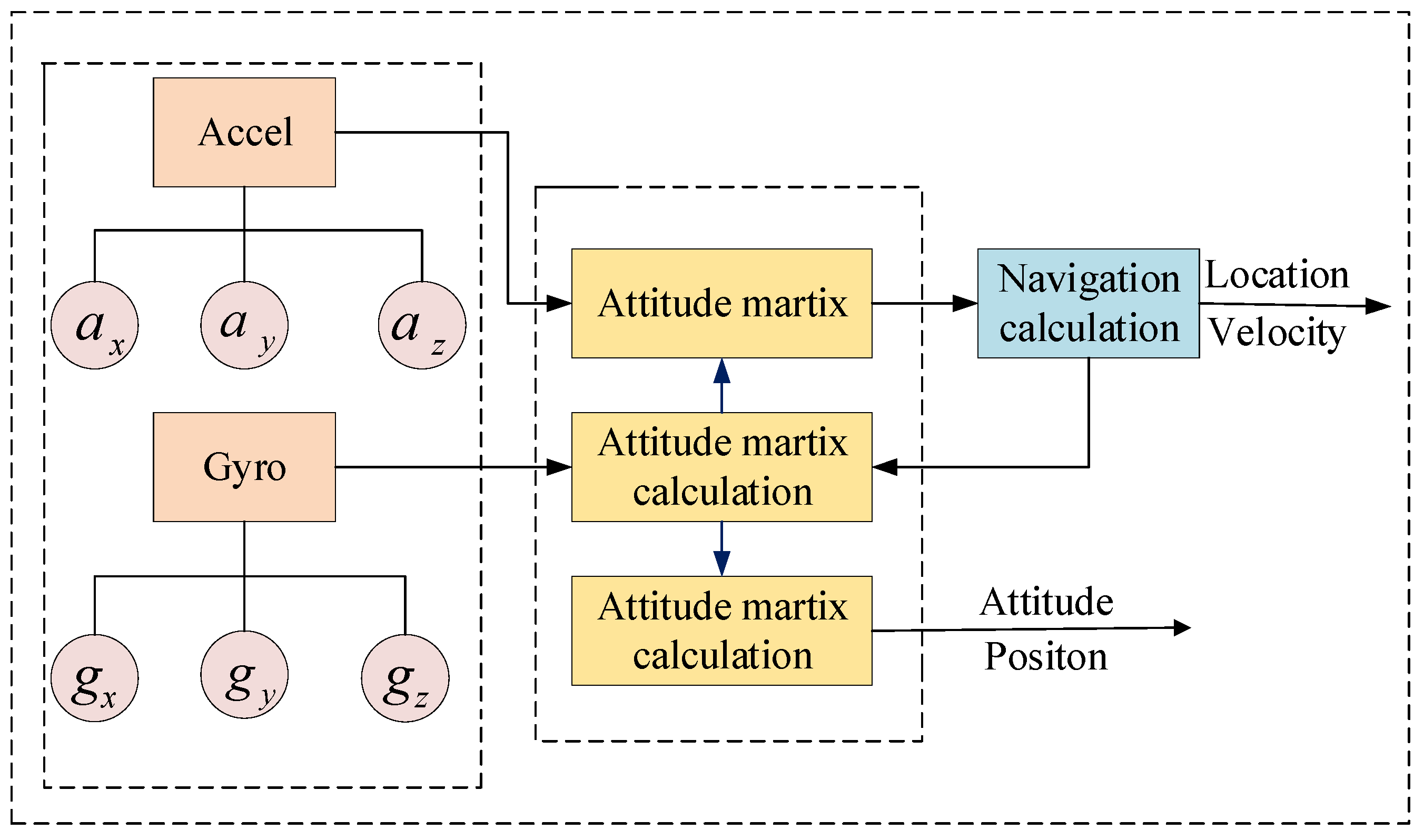
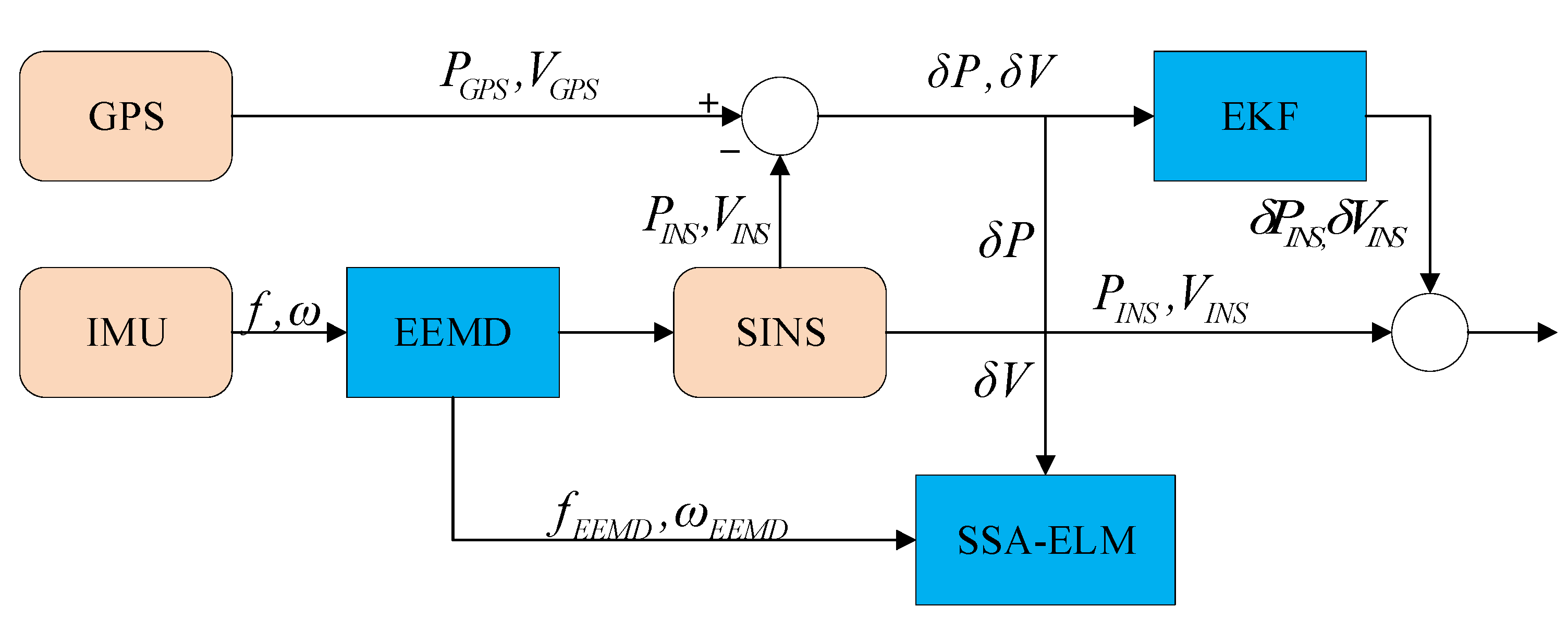

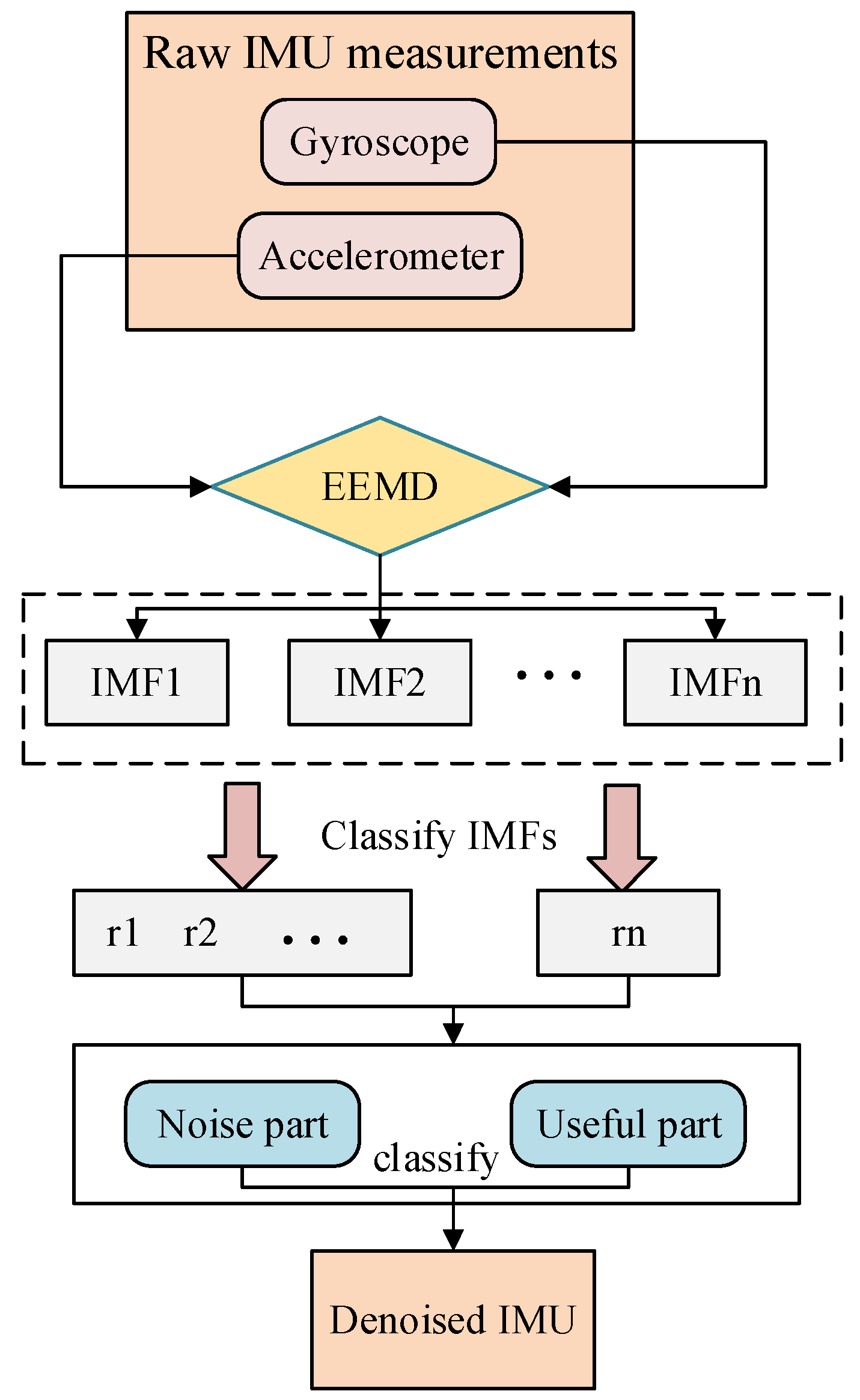
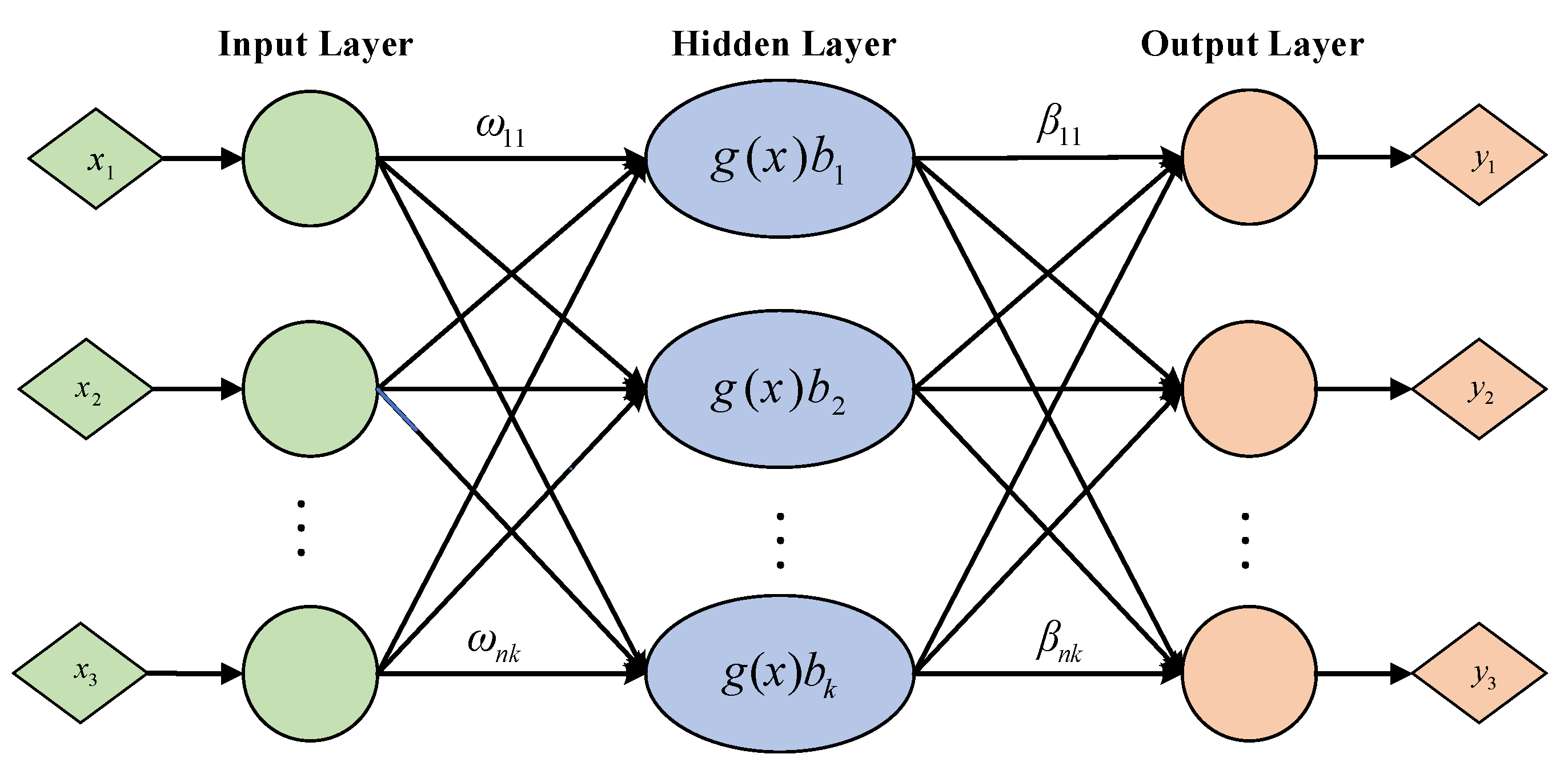
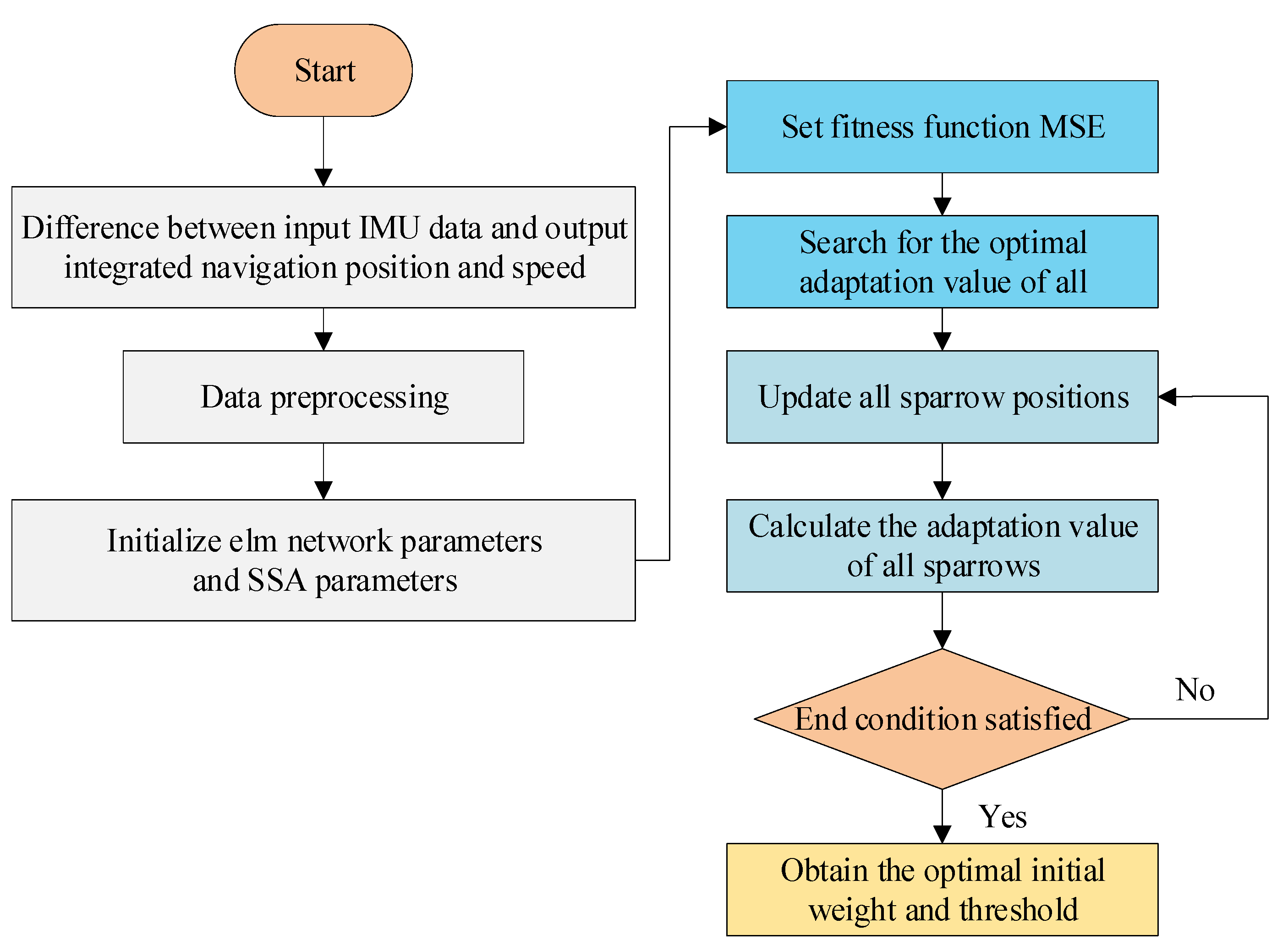


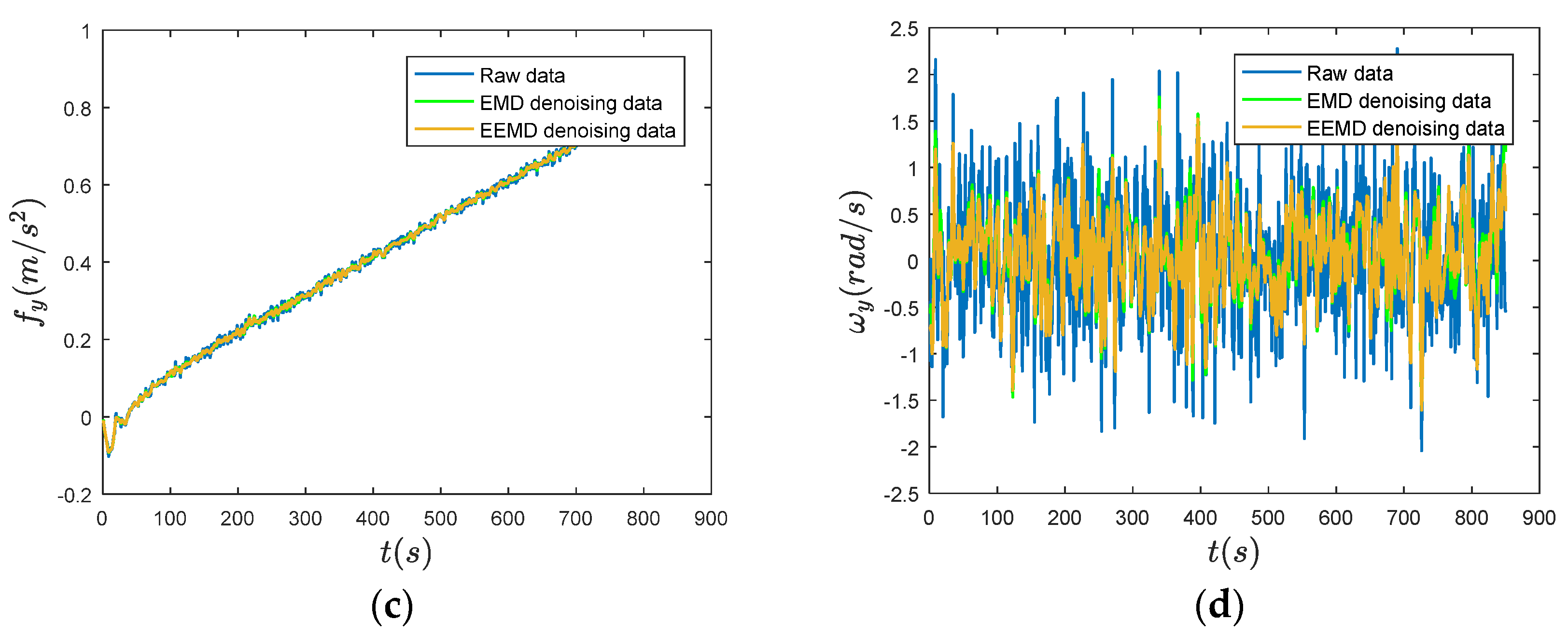

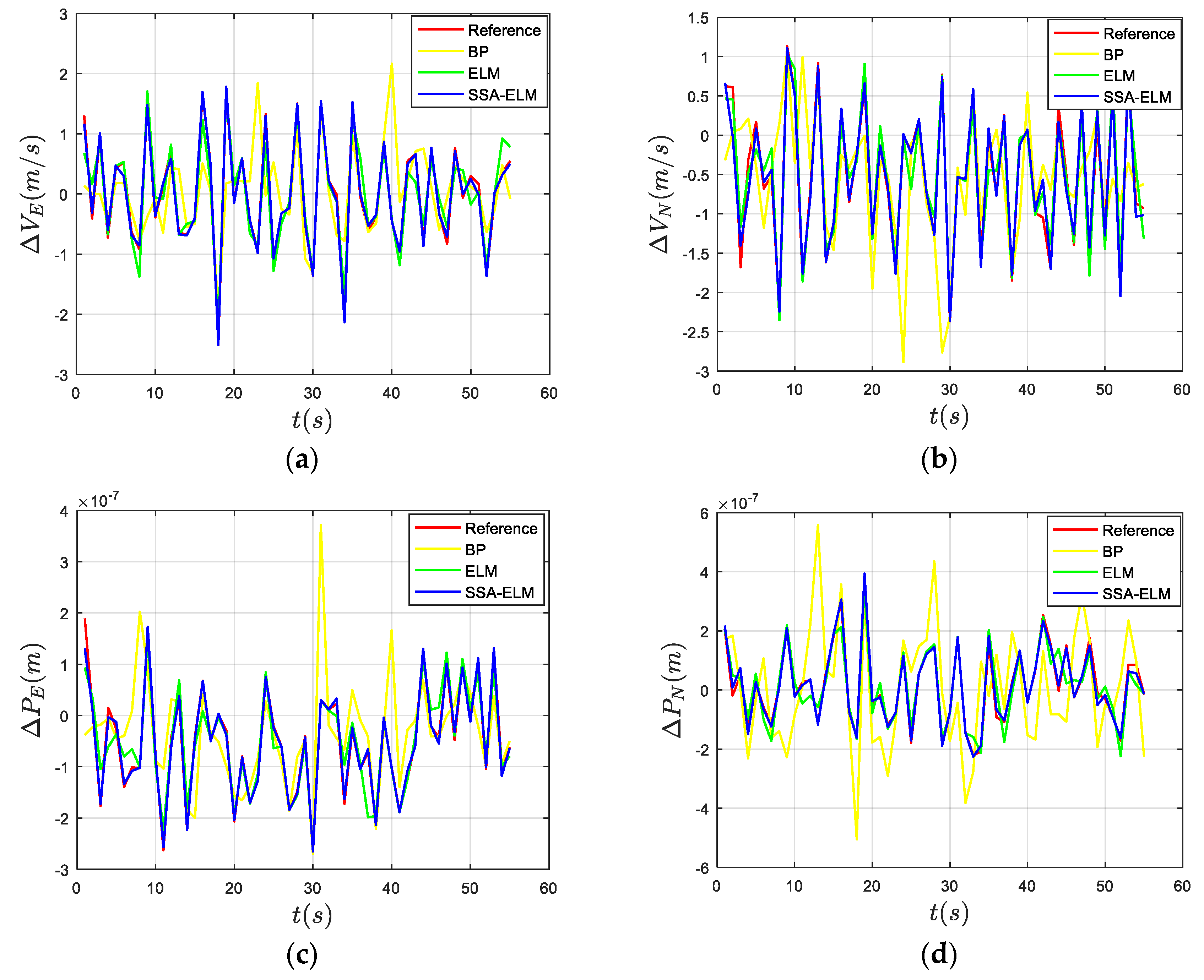

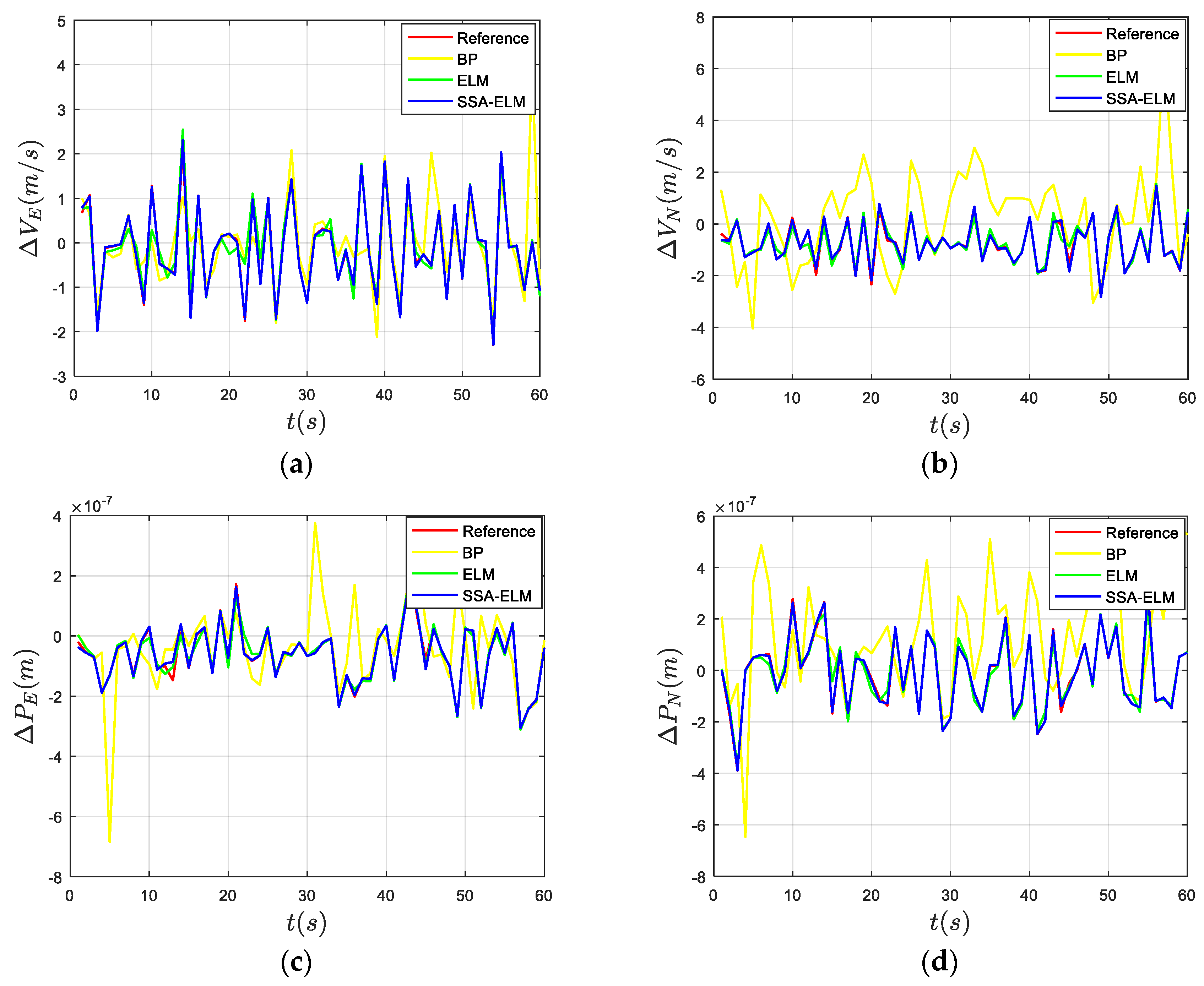
| Related Coefficient | Degree of Correlation |
|---|---|
| no linear relationship | |
| low-degree linear relationship | |
| significant linear relationship | |
| highly linear relationship |
| Experimental Equipment | Main Parameter | Value |
|---|---|---|
| Accelerometer Gyroscope | Resolving power Zero bias Roman walk resolving power Zero bias Roman walk | 0.3 mg 0.2 mg 0.2 m/s 0.07°/s 0.07°/s 1.9 s/ |
| GPS | GPS update rate Velocity error Position error | 1 Hz 0.1 m/s 2 m |
| Scheme | Sailing Time (s) | GPS Training Time (s) | GPS Interruption Time (s) |
|---|---|---|---|
| high-speed steering phase | 0–850 | 0–850 | 30 |
| low-speed steering phase | 0–850 | 0–850 | 60 |
| high-speed straight-line navigation phase | 0–850 | 0–850 | 30 |
| low-speed straight-line navigation phase | 0–850 | 0–850 | 60 |
| EMD denoising | 0.5904 | 0.5652 | 0.0297 | 0.0069 |
| EEMD denoising | 0.5847 | 0.5534 | 0.0296 | 0.0063 |
| EMD denoising | 4.5778 | 4.9557 | 30.5370 | 43.2673 |
| EEMD denoising | 4.6609 | 5.1398 | 30.5463 | 44.0195 |
| Error Indicator | BP | ELM | SSA-ELM | |
|---|---|---|---|---|
| /m/s | RMSE MAE | 1.0878 0.7920 | 0.4006 0.3036 | 0.2186 0.1252 |
| /m/s | RMSE MAE | 1.2776 0.8443 | 0.4392 0.3271 | 0.2151 0.1467 |
| RMSE MAE | 1.7131 × 10−6 1.2222 × 10−7 | 3.8987 × 10−8 2.8924 × 10−8 | 2.4579 × 10−8 1.3118 × 10−8 | |
| RMSE MAE | 1.4452 × 10−7 9.7608 × 10−8 | 5.9862 × 10−8 4.3075 × 10−8 | 1.9601 × 10−8 1.3199 × 10−8 |
| Error Indicator | BP | ELM | SSA-ELM | |
|---|---|---|---|---|
| /m/s | RMSE MAE | 0.8561 0.5968 | 0.2713 0.2097 | 0.0732 0.0492 |
| /m/s | RMSE MAE | 0.9955 0.6615 | 0.2188 0.1713 | 0.1502 0.0879 |
| RMSE MAE | 1.0118 × 10−7 6.9115 × 10−8 | 3.5438 × 10−8 2.3357 × 10−8 | 1.0840 × 10−8 6.2258 × 10−9 | |
| RMSE MAE | 1.9017 × 10−7 1.4695 × 10−7 | 4.6257 × 10−8 3.3467 × 10−8 | 1.3135 × 10−8 9.4451 × 10−9 |
| Error Indicator | BP | ELM | SSA-ELM | |
|---|---|---|---|---|
| /m/s | RMSE MAE | 0.9642 0.6691 | 0.3144 0.2209 | 0.0983 0.0555 |
| /m/s | RMSE MAE | 1.3712 1.1762 | 0.2460 0.1886 | 0.0503 0.0316 |
| RMSE MAE | 8.2396 × 10−7 5.5197 × 10−8 | 2.9593 × 10−8 2.0574 × 10−8 | 6.9779 × 10−9 4.6938 × 10−9 | |
| RMSE MAE | 1.0313 × 10−7 7.4401 × 10−8 | 4.7877 × 10−8 3.8411 × 10−8 | 6.6536 × 10−9 4.5647 × 10−9 |
| Error Indicator | BP | ELM | SSA-ELM | |
|---|---|---|---|---|
| /m/s | RMSE MAE | 0.8471 0.5344 | 0.2698 0.1554 | 0.0323 0.0182 |
| /m/s | RMSE MAE | 2.1322 1.6591 | 0.2016 0.1446 | 0.0801 0.0426 |
| RMSE MAE | 1.4343 × 10−7 8.2507 × 10−8 | 1.6845 × 10−8 1.1292 × 10−8 | 9.9519 × 10−9 3.9092 × 10−9 | |
| RMSE MAE | 2.6129 × 10−7 2.0455 × 10−7 | 2.7082 × 10−8 1.7762 × 10−8 | 6.1381 × 10−9 3.4930 × 10−9 |
Publisher’s Note: MDPI stays neutral with regard to jurisdictional claims in published maps and institutional affiliations. |
© 2022 by the authors. Licensee MDPI, Basel, Switzerland. This article is an open access article distributed under the terms and conditions of the Creative Commons Attribution (CC BY) license (https://creativecommons.org/licenses/by/4.0/).
Share and Cite
Xiao, J.; Li, Y.; Zhang, C.; Zhang, Z. INS/GPS Integrated Navigation for Unmanned Ships Based on EEMD Noise Reduction and SSA-ELM. J. Mar. Sci. Eng. 2022, 10, 1733. https://doi.org/10.3390/jmse10111733
Xiao J, Li Y, Zhang C, Zhang Z. INS/GPS Integrated Navigation for Unmanned Ships Based on EEMD Noise Reduction and SSA-ELM. Journal of Marine Science and Engineering. 2022; 10(11):1733. https://doi.org/10.3390/jmse10111733
Chicago/Turabian StyleXiao, Jiajia, Ying Li, Chuang Zhang, and Zhaoyi Zhang. 2022. "INS/GPS Integrated Navigation for Unmanned Ships Based on EEMD Noise Reduction and SSA-ELM" Journal of Marine Science and Engineering 10, no. 11: 1733. https://doi.org/10.3390/jmse10111733
APA StyleXiao, J., Li, Y., Zhang, C., & Zhang, Z. (2022). INS/GPS Integrated Navigation for Unmanned Ships Based on EEMD Noise Reduction and SSA-ELM. Journal of Marine Science and Engineering, 10(11), 1733. https://doi.org/10.3390/jmse10111733






